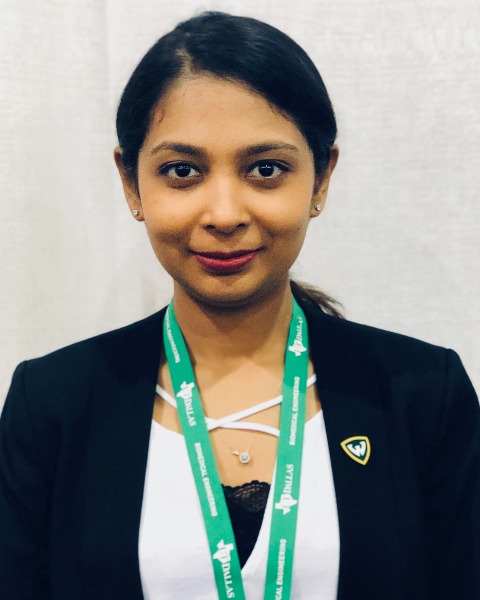Tissue Engineering
(M-513) Schwann Cell-Fibroblast Co-Culture on HA-CNT Nanofibers For In Vitro Model of NF1
Friday, October 13, 2023
9:30 AM - 10:30 AM PDT
Location: Exhibit Hall - Row M - Poster # 513

Judy Senanayake, MSc (she/her/hers)
PhD Candidate
Wayne State University
Lyon Charter Township, Michigan, United States
Harini Sundararaghavan
Associate Professor
Wayne State University, Michigan, United States
Presenting Author(s)
Co-Author(s)
Introduction:: Neurofibromatosis type 1(NF1) is a genetic condition characterized with peripheral nervous system tumors (PNSTs) including plexiform neurofibroma (pNFs) [1]. Plexiform Neurofibromas (pNF) are a pathological condition observed at birth in 20-25% NF1 patients [3]. Neurofibromas are complex tumors comprise of Schwann cells, endothelial cells, fibroblasts and infiltrating inflammatory mast cells [4]. Tumorigenesis is observed in pNFs due to nullizygous loss of NF1 in Schwann Cell (SC) and haploinsufficiency of NF1 in non-neuronal cells [5] The fibroblasts contribute significantly to tumorgenesis and recruitment of blood vessels by depositing collagen (accounting to 50% of tumor weight) to ensheathe the tumor components and remodeling of extracellular matrix to provide protein infrastructure. pNFs often lead to nerve dysfunction, deformity pain and damage. We are interested in investigating molecular pathways that drive the aberrant proliferation and invasiveness of SCs leading to neurofibromas. Bioengineered conductive polymers have been tested widely for their potential use in nerve regeneration. In this study we characterized the response of SCs isolated from NF1 patients and human fibroblasts in multiple cue in vitro model. This platform was developed to be utilized in drug testing for pNF in vitro.
Materials and Methods:: Hyaluronic acid nanofibrous scaffolds encapsulated with multiwalled carbon nanotubes (HA-CNT) were prepared through electrospinning as previously described [6]. Immortalized NF1 patient derived Schwann cell (NF-SC) line, ipNF95.11b [2], primary human fibroblasts (NHDF) and wild-type SC line (WT-SC), ipn02.8 [2] were characterized in this study. (a) Attachment Experiment: HA, HA-CNT with and without collagen coating were seeded with 25,000 cells, cultured for 24 hours and fixed and stained for s100b (red), phalloidin (green) and counterstained with DAPI (blue). (b) Proliferation Experiment: SCs were cultured on collagen-coated HA and HA-CNT fibers with hydrogel control for a duration of 72hrs and proliferation was evaluated with Alamar blue (AB) assay . (c) Electrical Stimulation: SC lines were cultured on custom stimulation well plates with HA-CNT nanofibers for 24h and the cells were stimulated at 20Hz biphasic square wave of 200mV/mm and 100mV/mm for 30mins. The stimulated plates and unstimulated controls were incubated for 40h and treated with AB to quantify the cell proliferation post electrical stimulation (ES). Cell supernatants from all wells were collected immediately post stimulation, 24h and 48h post ES. The plates were fixed and stained for s100b to analyze cell morphology post ES. (d) Growth Factor release: The cell supernatants collected from ES experiments were analyzed through a NGF capture ELISA. (e) Coculture of NHDF and NF: SCs and NHDF were cultured on collagen coated HA-CNT nanofibers at 1:1 proportion with necessary media modifications (25,000 total cells per well). The proliferation of coculture was evaluated at 24 and 48h post seeding.
Results, Conclusions, and Discussions:: Results and Discussion: The attachment experiment indicated a highly elongated cell morphology on both fiber types in NF-SCs and NHDFs compared to WT-SCs (Fig 1 (B,C,A)). The stained cells were analyzed for cellular spread area and aspect ratio. The proliferation data over a period of 72h time point post-seeding indicates that NF-SCs proliferate faster on HA fibers (16% between 24h and 72h) compared to HA-CNT fibers (4% between 24h and 72h). WT-SCs comparatively had higher proliferation on both fibers, HA (61% between 24h and 72h) and HA-CNT fibers (70% between 24h and 72h). The ES cells showed a less elongated morphology in NF-SCs while stimulated WT-SC had higher cellular spread area and aspect ratio compared to unstimulated cells. In addition, it was observed that NF1 cells proliferate less under stimulated conditions while unstimulated wells had greater proliferation. The ELISA results showed the release of NGF on both SC lines post ES at different time points. The NGF levels changed across the 48h time frame post ES on both cell lines. Co-culture proliferation tests across 48h of culture time indicated that NF cells proliferation was controlled (8% between 24h and 72h) while the proliferation of cells increased in co-culture of NHDF and NF-SC by 14%. NHDF cells cultured on HA-CNT fibers proliferated by 13% from 24h to 48h (Fig 1D). Proliferation studies confirm the role of fibroblast enhancing the SC activity.
Conclusion: This study characterized the behavior of NF1 patient SCs and highlights the role of ES to reduce the invasive behavior of neurofibroma SCs. In addition the co-culture tests confirm the role of fibroblasts driven cues for invasive proliferation of SCs similar to what is observed in tumor microenvironment. Further tests with be conducted with varying proportions of NHDF co-cultured along with NFs. Additional tests will be conducted to evaluate the variation of genes through qRT-PCR tests.
Acknowledgements (Optional): :
References (Optional): : 1.Ferrer, M. et al.,J.SData,2018, 5(1), 180106.
2.Kraniak, J.M. et al., J.ExpNeurol,2018, 299(Pt B), 289-298.
3.Prada, C.E. et al.,J.Pediatr,2012, 160(3), 461-467.
4.Le, LQ. et al., SJ. Onc, 2007, 26(32)
5.Yang, F.C. et al.,HMG (15),2006, 2421–2437
6.Steel, E.M. et al.,J.Mtla,2020, 9, 100581.
Materials and Methods:: Hyaluronic acid nanofibrous scaffolds encapsulated with multiwalled carbon nanotubes (HA-CNT) were prepared through electrospinning as previously described [6]. Immortalized NF1 patient derived Schwann cell (NF-SC) line, ipNF95.11b [2], primary human fibroblasts (NHDF) and wild-type SC line (WT-SC), ipn02.8 [2] were characterized in this study. (a) Attachment Experiment: HA, HA-CNT with and without collagen coating were seeded with 25,000 cells, cultured for 24 hours and fixed and stained for s100b (red), phalloidin (green) and counterstained with DAPI (blue). (b) Proliferation Experiment: SCs were cultured on collagen-coated HA and HA-CNT fibers with hydrogel control for a duration of 72hrs and proliferation was evaluated with Alamar blue (AB) assay . (c) Electrical Stimulation: SC lines were cultured on custom stimulation well plates with HA-CNT nanofibers for 24h and the cells were stimulated at 20Hz biphasic square wave of 200mV/mm and 100mV/mm for 30mins. The stimulated plates and unstimulated controls were incubated for 40h and treated with AB to quantify the cell proliferation post electrical stimulation (ES). Cell supernatants from all wells were collected immediately post stimulation, 24h and 48h post ES. The plates were fixed and stained for s100b to analyze cell morphology post ES. (d) Growth Factor release: The cell supernatants collected from ES experiments were analyzed through a NGF capture ELISA. (e) Coculture of NHDF and NF: SCs and NHDF were cultured on collagen coated HA-CNT nanofibers at 1:1 proportion with necessary media modifications (25,000 total cells per well). The proliferation of coculture was evaluated at 24 and 48h post seeding.
Results, Conclusions, and Discussions:: Results and Discussion: The attachment experiment indicated a highly elongated cell morphology on both fiber types in NF-SCs and NHDFs compared to WT-SCs (Fig 1 (B,C,A)). The stained cells were analyzed for cellular spread area and aspect ratio. The proliferation data over a period of 72h time point post-seeding indicates that NF-SCs proliferate faster on HA fibers (16% between 24h and 72h) compared to HA-CNT fibers (4% between 24h and 72h). WT-SCs comparatively had higher proliferation on both fibers, HA (61% between 24h and 72h) and HA-CNT fibers (70% between 24h and 72h). The ES cells showed a less elongated morphology in NF-SCs while stimulated WT-SC had higher cellular spread area and aspect ratio compared to unstimulated cells. In addition, it was observed that NF1 cells proliferate less under stimulated conditions while unstimulated wells had greater proliferation. The ELISA results showed the release of NGF on both SC lines post ES at different time points. The NGF levels changed across the 48h time frame post ES on both cell lines. Co-culture proliferation tests across 48h of culture time indicated that NF cells proliferation was controlled (8% between 24h and 72h) while the proliferation of cells increased in co-culture of NHDF and NF-SC by 14%. NHDF cells cultured on HA-CNT fibers proliferated by 13% from 24h to 48h (Fig 1D). Proliferation studies confirm the role of fibroblast enhancing the SC activity.
Conclusion: This study characterized the behavior of NF1 patient SCs and highlights the role of ES to reduce the invasive behavior of neurofibroma SCs. In addition the co-culture tests confirm the role of fibroblasts driven cues for invasive proliferation of SCs similar to what is observed in tumor microenvironment. Further tests with be conducted with varying proportions of NHDF co-cultured along with NFs. Additional tests will be conducted to evaluate the variation of genes through qRT-PCR tests.
Acknowledgements (Optional): :
References (Optional): : 1.Ferrer, M. et al.,J.SData,2018, 5(1), 180106.
2.Kraniak, J.M. et al., J.ExpNeurol,2018, 299(Pt B), 289-298.
3.Prada, C.E. et al.,J.Pediatr,2012, 160(3), 461-467.
4.Le, LQ. et al., SJ. Onc, 2007, 26(32)
5.Yang, F.C. et al.,HMG (15),2006, 2421–2437
6.Steel, E.M. et al.,J.Mtla,2020, 9, 100581.
